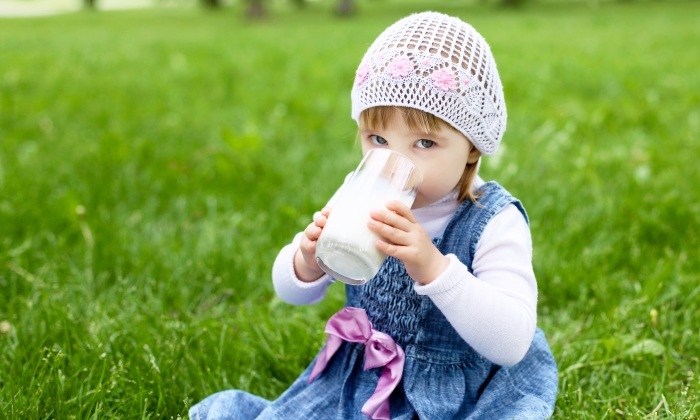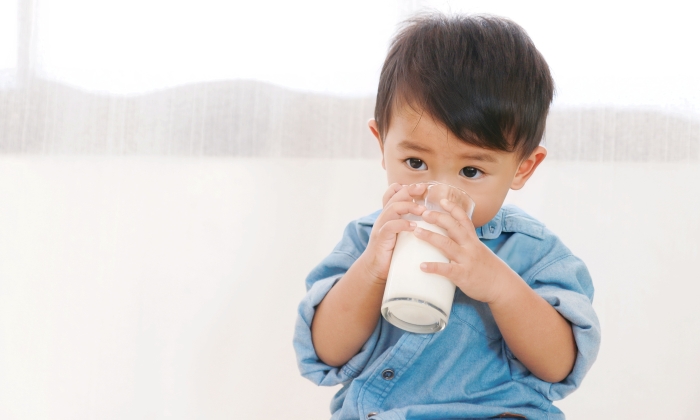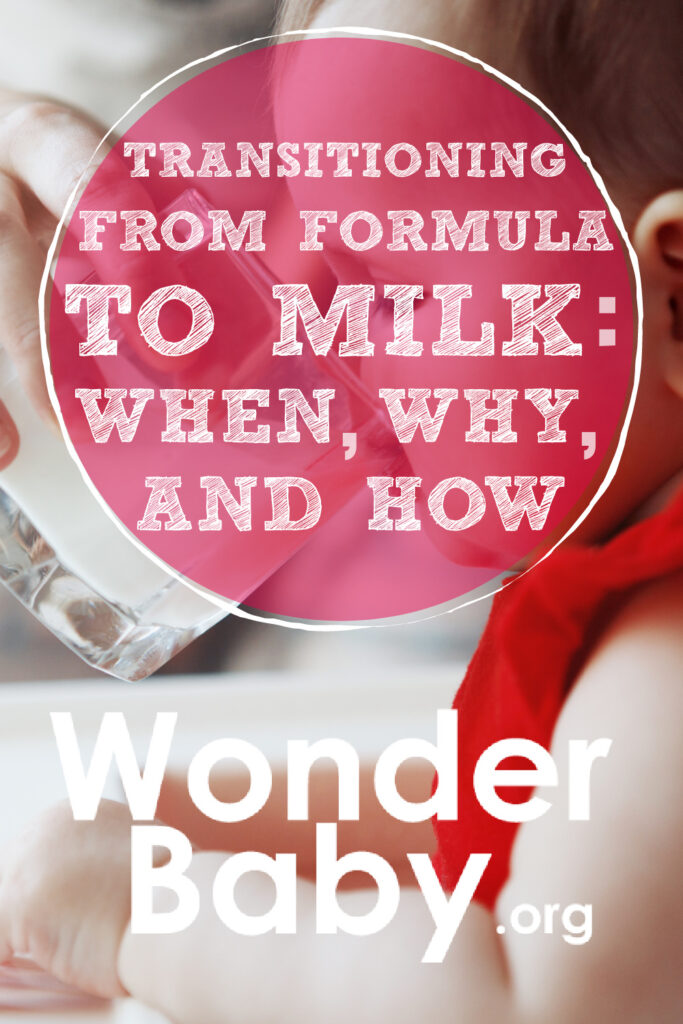Transitioning From Formula to Milk: When, Why, and How

- Babies should continue to drink formula or breastmilk throughout their first year of life.
- After twelve months, most babies are ready to begin transitioning from breastmilk or formula to whole cow’s milk.
- Introduce cow’s milk gradually to prevent digestive issues.
- Offer whole milk with vitamin D to toddlers in a sippy cup or straw cup rather than a bottle.
Newborns and infants should drink only breast milk or formula for the first six months of their life. By around 6 months old, you can start feeding your baby solid foods, either with baby food or through strategies like baby-led weaning.
As your baby gets older, they should be able to handle more table foods and won’t need as much breastmilk or formula. Once they’re old enough, they should switch from formula to regular milk.
While it can feel like a big change, most babies do just fine when transitioning from formula to milk.
At What Age Should Babies Stop Having Formula?
Most babies can stop drinking formula when they’re about a year old. However, every child has different nutritional needs, and some babies will need to continue to drink formula well into their second year of life.
Older Babies and Formula
While rare, some babies may need the nutritional support of formula up until their second birthday. Your child’s pediatrician can help you decide what is best for your baby.
Children may need to continue formula if they:
- Were born prematurely.
- Have kidney or liver problems.
- Are diagnosed with a metabolic condition.
- Have trouble gaining weight.
- Do not eat solid foods.
When Can You Start Giving Your Baby Milk Instead of Formula?

Some parents are anxious to wean their babies from formula. Formula can get expensive, and dealing with problems like formula shortages is extremely stressful.
Even when your baby starts eating solids, they still need to get most of their nutrients from breast milk or formula. You should wait until your baby is at least one year old before letting them drink cow’s milk or other milk alternatives.
Cow’s Milk Before 12 Months
The American Academy of Pediatrics warns that giving your baby cow’s milk before their first birthday can cause problems like iron deficiency anemia, stress the kidneys, and irritate the lining of the stomach.
Even though babies’ digestive systems are not ready for cow’s milk before twelve months of age, it’s okay to give them tastes of cheese, yogurt, and other dairy products as soon as you introduce solid foods.
Formula Shortages
During formula shortages, you can give your baby some cow’s milk if they are over six months old. However, this is not a good long-term solution. If your baby is under one year old, you should not replace formula with cows’ milk for more than one week, according to the CDC.
Many special programs are available for families facing formula shortages or who are struggling to afford formula for their babies. Your pediatrician should be able to help you access these resources.
Why Do Babies Need to Transition From Formula to Milk?

As your baby gets older, they should get more of their nutrition from whole foods. When your baby starts to enjoy eating solid foods and reaches twelve months of age, they no longer need the calories or nutrients from infant formula.
How to Transition From Formula to Milk
Most babies have a smooth transition from formula to milk. However, you should be especially cautious about introducing cow’s milk if you have a family history of milk allergies.
Start Slowly
The switch from infant formula to cow’s milk should be a gradual process. Giving your baby too much milk can be hard on their digestive system. Start with just 1 to 2 ounces of milk as you slowly reduce your baby’s formula intake.
Choose Whole Milk
Babies should drink whole milk fortified with vitamin D until at least their second birthday. Whole milk contains enough fat and other important nutrients to support a growing toddler.
While the adults in your family may choose reduced-fat or fat-free dairy products, babies should always have whole milk.
While there are many milk alternatives out there like soy milk, almond milk, and oat milk, cow’s milk is the best choice for your growing child.
If your baby has a cow’s milk allergy, fortified soy milk is the best replacement. Try to find soy milk that has been fortified with vitamin D and does not contain any added sugars.
Practice With a Sippy Cup
Around the same time your formula-fed baby is ready to switch to plain milk, they should also be ready to replace their bottle with sippy cups or straws.
Babies who continue drinking milk through a bottle past one year old are at risk of dental problems and cavities.
Remember: Milk is Not a Meal
By the time you make the transition to whole milk, your baby should get most of their nutrition from solid food. One-year-old babies and toddlers should drink between 8 and 24 oz of whole milk each day.
If you haven’t already, this is also a good time to wean your baby from their bottle at night.
How Long Does It Take to Switch From Formula to Milk?

The Cleveland Clinic recommends weaning your child from formula to whole cow’s milk over a period of 10 days. This can be done in two different ways:
- Give your baby a 2- to 4-ounce serving of milk for every two servings of formula. You can give this milk with meals or as a replacement for one formula feeding. Slowly continue to replace formula to whole milk until your baby no longer drinks formula at all.
- Make formula as you normally would, then mix 2 ounces of formula with 2 ounces of cow’s milk and give the mixture to your baby. Replace more formula with cow’s milk slowly until you no longer add any formula to the mixture.
Cow’s Milk Allergy
While rare, some babies do have allergies to cow’s milk and other dairy foods. Signs of milk allergy in children include:
- Hives
- Rash
- Wheezing
- Coughing
- Shortness of breath
- Itching
- Swelling of the face, lips, tongue, or throat
- Vomiting
- Diarrhea
- Blood in stool
- Abdominal cramps
- Runny nose
- Watery eyes
If your child shows any of these symptoms, it’s important to take them to see a healthcare provider right away. If you notice wheezing, difficulty breathing, or swelling of the face, lips or tongue, call 911.

FAQs
Does baby poop change when they start whole milk?
You may notice that your baby’s poop changes when switching from breast milk or formula to whole milk. This is completely normal and nothing to worry about. Baby poop usually changes from green, brown, or dark yellow to light brown or tan when switching to whole milk.
Is it normal for babies to have diarrhea when switching to milk?
Your baby should not have diarrhea when switching to milk. If you notice that your baby has diarrhea or throws up while you are introducing cow’s milk, talk to your family doctor or pediatrician.
What can you do if your child doesn’t like milk?
If your child has a hard time with the taste of cow’s milk, you can mix the milk with formula. Gradually increase the amount of milk mixed in with the formula until they get used to the taste.
How much milk should a toddler drink every day?
A toddler should drink at least one cup of milk each day, and not more than 24 oz.
Should I use toddler formula instead of cow’s milk?
For most children, toddler formula is not necessary. In fact, most toddler formulas have more sugar and fewer nutrients than whole cow’s milk. Unless your doctor recommends using a special toddler formula, save yourself the extra money and stick to plain milk.
References
- Cow’s Milk and Milk Alternatives. Centers for Disease Control and Prevention. Updated May 20, 2022. Accessed May 24, 2023. https://www.cdc.gov/nutrition/InfantandToddlerNutrition/foods-and-drinks/cows-milk-and-milk-alternatives.html
- Decreasing Community Toddler Formula Use. American Academy of Pediatrics. Updated April 14, 2022. Accessed May 24, 2023. https://www.aap.org/en/advocacy/community-health-and-advocacy/community-pediatrics-funded-projects/decreasing-community-toddler-formula-use/
- How to Tell if Your Baby is Ready to Stop Drinking Formula. Cleveland Clinic. Published September 21, 2021. Accessed May 24, 2023. https://health.clevelandclinic.org/how-to-tell-if-your-baby-is-ready-to-stop-drinking-formula/
- Information for Families During the Infant Formula Shortage. Centers for Disease Control and Prevention. Updated July 6, 2022. Accessed May 24, 2023. https://www.cdc.gov/nutrition/infantandtoddlernutrition/formula-feeding/infant-formula-shortage.html
- Why Do Infants Need Baby Formula Instead of Cow’s Milk? American Academy of Pediatrics. Updated May 11, 2022. Accessed May 24, 2023. https://www.healthychildren.org/English/ages-stages/baby/formula-feeding/Pages/Why-Formula-Instead-of-Cows-Milk.aspx

The information WonderBaby provides is not intended to be, and does not constitute, medical or other health advice or diagnosis and should not be used as such. Always consult with a qualified medical professional about your specific circumstances.
Related Posts

Eye Conditions and Syndromes, Visual Impairment
Neuralink Announces Plans to Restore Sight to the Blind with Brain Chip
Elon Musk’s company Neuralink has announced plans to begin human trials of its new “Blindsight” brain chip by the end of 2025.

Health & Nutrition
Can Baby Skin Care Products Expire?
Is that forgotten tube of diaper rash cream still safe to use? Learn more about the expiration dates of popular skin care products for infants.

Health & Nutrition
Boosting Immunity in Kids: 3 Tips for a Healthy Winter
Parents can help boost their kids’ immunity during cold and flu season by maintaining healthy eating, sleeping, and exercising habits in the winter.